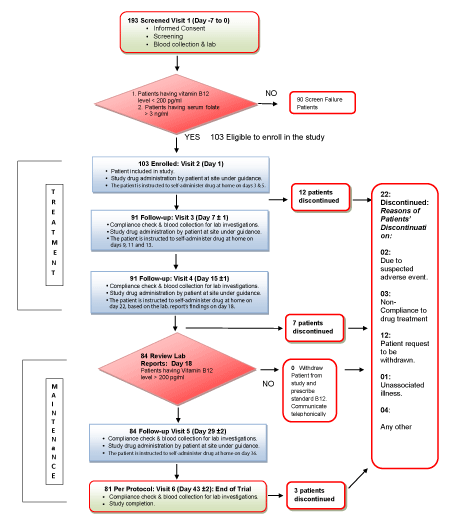
Figure 1: Flow diagram for patient screened, selected and included in the study.


Tulika Seth1 Vikas Suri2 Dushyant Balat3 Sachin Murthy4 Ajay Agarwal5 Prabu Pandurangan6 Prantar Chakrabarti7 Arun Maseeh8* Ketan R Patel8
1Department of Hematology, All India Institute of Medical Sciences (AIIMS), New Delhi, India*Corresponding authors: Dr. Arun Maseeh, Medical Department, Troikaa Pharmaceuticals Limited, Bodakdev, Ahmedabad, India 380054, Tel: +91- 7926856242; E-mail: arunmaseeh@troikaapharma.com
Background & Aims: Methylcobalamin nasal spray (NasoB12® ) has been developed to overcome the drawbacks of currently available therapeutic options like the poorly absorbed oral route and the painful intramuscular route. The present study was designed to evaluate the safety and efficacy of NasoB12® in patients with Vitamin B12 deficiency, with serum vitamin B12 (svB12) <200 pg/mL (148 pmol/L).
Methods: This prospective, multicentric, open-label, clinical study was conducted in 103 vitamin B12-deficient patients (58 men, 45 women; 18-55 years). In the treatment phase of interventions, 7 doses of NasoB12® 500 mcg/dose on alternate days for 2 weeks were given. Patients with Vitamin B12 >200 pg/mL (148 pmol/L) after two weeks of treatment received maintenance therapy with weekly NasoB12® 500 mcg/dose for 4 weeks. Primary outcome was the proportion of patients with svB12 levels >200 pg/ml after 2nd and 6th weeks. Secondary outcomes included svB12 levels and blood hemoglobin.
Results: After 2nd and 6th weeks of treatment, 100% (81/81) and 95.06% (77/81) of patients achieved svB12 levels >200 pg/mL (148 pmol/L) respectively. Mean svB12 levels increased significantly from 123.10 pg/mL (baseline) to 530.07, 718.69, 627.76 and 676.70 pg/mL after 1st, 2nd, 4th and 6th weeks respectively.
Hemoglobin significantly increased from 11.94 g/dL (baseline) to 12.39, 12.76, 13.25 and 13.58 g/dL after the 1st, 2nd, 4th and 6th weeks respectively. Reticulocyte count, demonstrated trend consistent with erythpoietic activity: a borderline higher value at 1st and 2nd weeks; and once hemoglobin approached 12.76 g/dL, the reticulocyte count started normalizing; but the hemoglobin kept rising till normal.
No serious/severe treatment-emergent adverse events were reported.
Conclusion: NasoB12® is well-tolerated and rapidly corrects vitamin B12 deficiency with a rise in hemoglobin. NasoB12® offers a favorable alternative to oral/intramuscular B12 formulations.
Clinical Trial Registry: CTRI No.: CTRI/2015/06/005952 at www.ctri.nic.in.
Methylcobalamin; Nasal spray; Vitamin B12 Deficiency; Novel Drug Delivery System Hemoglobin; Anemia
Vitamin B12 (B12, also known as cobalamin) is a B vitamin that has an important role in cellular metabolism, especially in DNA synthesis, methylation and mitochondrial metabolism [1]. Serum vitamin B12 (svB12) levels, that are low (<150 pg/mL) or low-normal (150-399 pg/ mL) [2] may lead to hematologic, neurologic, gastrointestinal, and vascular consequences [3].
Vitamin B12 deficiency has a global incidence of 5%-60% [4]. Plasma Vitamin B12 concentrations were assessed cross-sectionally for 2999 subjects in the general population of the Framingham Offspring Study: 39% had serum vitamin B12 levels <258 Pmol/L (<350 pg/mL) [5,6]. A large (n=176,702) neonatal and maternal study demonstrated the advantages of identifying and correcting B12 deficiency [7].
The administration of B12 by the nasal route has a 70-year history, starting from nasal drops used for treating patients suffering from pernicious anemia [8] to cyanocobalamin nasal spray in the recent decades. Considering the potential advantages offered by a nasal spray over oral/injectable routes, and of methylcobalamin over other forms, a novel methylcobalamin nasal spray has been recently developed and received regulatory approval (Troikaa Pharmaceuticals Limited). In a first-in-human randomized, single-dose, two-way crossover comparative bioavailability study conducted at a CRO for global regulatory approvals, it was found that the relative bioavailability of NasoB12® was 20% that of intramuscular methylcobalamin (Clinical Trial Registry: CTRI/2015/04/005687). In this study we have evaluated the safety and efficacy of NasoB12® in patient with Vitamin B12 deficiency (svB12 <200 pg/mL (148 pmol/L)).
This prospective, multicentric, open-label, clinical study was conducted in accordance with declaration of Helsinki (59th WMA General Assembly, Seoul, October 2008); Schedule Y (amended version, 2005) of CDSCO, India; Ethical Guidelines for Biomedical Research on Human Participants, ICMR (2006); and ICH, E6- Guideline for GCP. Enrollment for this clinical trial began in late 2015, and ended in late 2018. The trial was conducted at 7 urban tertiary care centers. Electrochemiluminescence immunoassay (ECLIA) and Spectophotometry methods were used to determine serum vitamin B12 and hemoglobin respectively.
The trial protocol and informed consent form were reviewed, approved, monitored and overseen by a duly constituted Independent Ethics Committee (IEC) at each site. Informed consent was obtained from each patient. The contract research organization, QED clinical services private limited, was responsible for data management, statistical analysis, clinical study report writing. Full details of the trial design, conduct, oversight, and analyses can be found in the protocol and statistical analysis plan.
193 consecutive asymptomatic adults aged 18-72 years, who gave written informed consent were screened for vitamin B12 deficiency at 7 tertiary hospitals. Out of these 103 patients (58 men, 45 women) with svB12 <200 pg/mL (148 pmol/L) when screened were included. Individuals with known hypersensitivity or cobalt allergy or any background illness were excluded. (More details about Protocol INMEC CT/31/01/12 are available on the Clinical Trial Registry: CTRI/2015/06/005952).
NasoB12® (Methylcobalamin 250 mcg/0.05 mL/actuation) was administered as 1 actuation per nostril, i.e. 2 actuations/500 mcg dose. Patients were treated with 500 mcg intranasal methylcobalamin total 2 actuations at a time on alternate days for 2 weeks (7 doses) in treatment phase and with 500 mcg intranasal methylcobalamin, once in a week for 4 weeks (4 doses) in maintenance phase. Total 11 doses of the study drug were given to the patient during the study. Since all forms of Vitamin B12 are destroyed by light, precautions were taken to prevent photodegradation included the use of amber coloured USP type I glass vial as primary pack and specially coated outer-cartons as a secondary pack to protect the formulation from light.
Assuming an overall success rate of 75% at treatment phase and 85% at maintenance phase compared to null hypothesis of 60% success rate, at least 32 efficacy evaluable subjects were required to complete the study. By assuming 40% drop out at treatment phase and 25% dropout at maintenance phase, 72 subjects were required to achieve 90% power with 5% level of significance. [Software: PASS (Power Analysis and Sample size) version 11]. However, as per local regulatory recommendations, 100 patients were to be enrolled in this study.
For efficacy assessment, primary efficacy endpoint was evaluated as the proportion of patients achieving svB12 levels >200 pg/mL (148 pmol/L) after the 2nd and 6th week. The secondary endpoints included svB12 and hemoglobin levels after the 1st, 2nd, 4th, 6th weeks of treatment. Further the Physician’s Global Assessment of Efficacy was assessed as secondary end point. Efficacy assessment was done on Per Protocol Population (PP) which consisted of the subjects who completed the study in compliance with the protocol and had no major protocol violations that impacted the efficacy assessments.
Incidence/severity of Treatment-Emergent Adverse Events (TEAEs), abnormality in vital signs/physical examination, and global tolerability were included in safety assessment. Safety analyses were performed on safety population where all subjects who received at least one dose of the study medication were included. Summary statistics were presented as numbers and percentages of patients experiencing treatment emergent adverse events.
In general, continuous data was presented by descriptive statistics i.e. n, mean, standard deviation, median, minimum and maximum values. Categorical data was presented as frequency (n) and percentage. Visit 1 (Day-7 to 0) was considered as the Baseline visit.
The statistical analysis was done in accordance with the ICH-E9 guidelines “Statistical Principles for Clinical Trials” and guidelines from CDSCO and USFDA guideline and applicable regulatory guidelines. All reports outputs were produced using SAS® version 9.4 in a secure and validated environment. (Statistical analysis plan, version 1.0:27NOV2017).
A total of 193 patients were screened, and 103 were enrolled (Figure 1).

Figure 1: Flow diagram for patient screened, selected and included in the study.
Eligibility was based on the Vitamin B12<200 pg/mL (148 pmol/L) & Folate levels > 3 ng/mL.
81 patients (78.6%) completed the study and were included in the efficacy analysis (Per Protocol Population). Total 103 patients were evaluated for safety analysis.
The mean age of the patient was 38.45 years with BMI of 23.83 kg/m2. There were 56.3% of male and 43.7 % were of female patients (Table 1A).
| Characteristics | |
| Age (Years) | |
| Mean | 38.45 |
| Min, max | 18, 72 |
| Males: Mean | 39.44 |
| Males: Min, max | 18, 72 |
| Females: Mean | 37.15 |
| Females: Min, max | 18, 55 |
| Gender, n (%) | |
| Male | 58 (56.3) |
| Female | 45 (43.7) |
| BMI (kg/m2) | |
| Mean | 23.83 |
| Min, max | 13.5, 37.8 |
| Males: Mean | 24.04 |
| Males: Min, max | 14.5,32.3 |
| Females: Mean | 23.54 |
| Females: Min, max | 13.5,37.8 |
| Serum vitamin B12 levels pg/ml : Baseline | |
| Mean | 123.1 |
| Min, max | 13.75,570 |
| Males: Mean | 124.13 |
| Males: Min, max | 48.3, 570 |
| Females: Mean | 123.76 |
| Females: Min, max | 13.75, 197 |
| Hb levels g/dL : Baseline | |
| Mean | 11.94 |
| Min, max | 6.2, 16.5 |
| Males: Mean | 12.62 |
| Males: Min, max | 6.2, 16.5 |
| Females: Mean | 11.03 |
| Females: Min, max | 7.7,13.6 |
Table 1A: Demographic characteristics of study participants and baseline data (N=103).
100% (81/81) and 95.06% (77/81) patients had B12 > 200 pg/mL (148 pmol/L) after the 2nd and 6th weeks respectively (p<0.0001) (Table 1B, Figure 2).
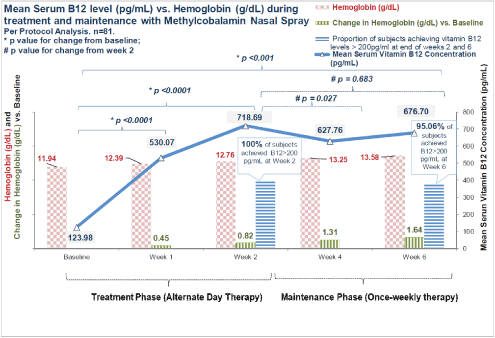
Figure 2: Mean Serum B12 level (pg/mL) vs. Hemoglobin (g/dL) during treatment and maintenance with Methylcobalamin nasal spray: Per Protocol Analysis. n=81. Secondary efficacy endpoints.
| Proportion of patients with serum vitamin B12 levels >200 pg/mL (148 pmol/L) at the end of the 2nd week; % (n=) | 100% (n=81) | Hemoglobin levels g/dL: end of week 1 | |
| Overall Proportion % and (n) | 100% (n=81/81 | Mean | 12.39 |
| Males Proportion % and (n) | 100% (n=46/46) | Min, max | 8.2, 16.5 |
| Females Proportion % and (n) | 100% (n=35/35) | Males: Mean | 13.03 |
| Proportion of patients with serum vitamin B12 levels >200 pg/mL (148 pmol/L) at the end of the 6th week; % (n=) | 95.06% (n=77/81) | Males: Min, max | 8.2, 16.5 |
| Overall Proportion % and (n) | 95.06% (n=77/81) | Females: Mean | 11.54 |
| Males Proportion % and (n) | 95.6% (n=44/46) | Females: Min, max | 8.3, 13.9 |
| Females Proportion % and (n) | 94.28% (n=33/35) | Hemoglobin levels g/dL: end of week 2 | |
| Serum vitamin B12 levels pg/ml : end of week 1 | Mean | 12.76 | |
| Mean | 530.07 | Min, max | 8.7, 16.8 |
| Min, max | 133.9,>2000 | Males: Mean | 13.36 |
| Males: Mean | 589.5 | Males: Min, max | 8.7,16.8 |
| Males: Min, max | 154.9, 2000 | Females: Mean | 11.97 |
| Females: Mean | 451.9 | Females: Min, max | 8.9, 13.6 |
| Females: Min, max | 133.9, >2000 | Hemoglobin levels g/dL: end of week 4 | |
| Serum vitamin B12 levels pg/ml : end of week 2 | Mean | 13.25 | |
| Mean | 718.69 | Min, max | 10, 16.5 |
| Min, max | 206.8, 2106 | Males: Mean | 13.81 |
| Males: Mean | 720.4 | Males: Min, max | 10, 16.5 |
| Males: Min, max | 206.8, 2000 | Females: Mean | 12.49 |
| Females: Mean | 716.4 | Females: Min, max | 10.2, 14.6 |
| Females: Min, max | 208, 2106 | Hemoglobin levels g/dL: end of week 6 | |
| Serum vitamin B12 levels pg/ml : end of week 4 | Mean | 13.58 | |
| Mean | 627.76 | Min, max | 8.7, 17.2 |
| Min, max | 219.5, 2000 | Males: Mean | 14.16 |
| Males: Mean | 603.4 | Males: Min, max | 11.3, 17.2 |
| Males: Min, max | 219.5, 2000 | Females: Mean | 12.81 |
| Females: Mean | 659.7 | Females: Min, max | 8.7, 15.2 |
| Females: Min, max | 257.5, 1871 | ||
| Serum vitamin B12 levels pg/ml : end of week 6 | |||
| Mean | 676.7 | ||
| Min, max | 100.5, 7200 | ||
| Males: Mean | 781 | ||
| Males: Min, max | 169, 7200 | ||
| Females: Mean | 539.5 | ||
| Females: Min, max | 100.5, 1380 | ||
Table 1B: Outcomes by gender (N=103).
Vitamin B12 levels: Statistically significant changes in B12 levels (pg/mL) were observed from 123.98 at Baseline, to 530.07 and 718.69 after the 1st and 2nd week respectively (“Treatment Phase”) (both p<0.0001) and 676.70 pg/mL after the 6th week (“Maintenance Phase”) (p <0.001 [Student‘t’ test]) (Figure 2).
A transient statistically significant change was observed in B12 levels after the 4th week as compared to the 2nd week, which was considered clinically acceptable considering the reduction in dosing frequency from alternate-day to once-weekly dosing. (Change at 4th and 6th weeks were: -90.93 pg/mL; (p= 0.027) and -41.99 pg/mL (p=0.683) respectively. Thus, by the end of the 6th week, the decrease in B12 level was insignificant as compared to 2nd week. The significant aspect of weekly therapy is that mean B12 levels were maintained well above 400 pg/mL.
Hemoglobin levels: Hemoglobin increased rapidly after the 1st, 2nd, 4th, and 6th weeks: from Baseline 11.94 to 12.39, 12.76, 13.25 and 13.58 g/dL respectively (p versus baseline <0.0001 [from Binomial Exact test]). The change in hemoglobin versus baseline after the 1st, 2nd, 4th, and 6th weeks was: 0.45, 0.82, 1.31 and 1.64 g/dL respectively (p= 0.0002 at week 1; p <0.0001 at weeks 2, 4 and 6) (Figure 2).
A review of ‘Prior and Concomitant Medication’ confirmed that only 3.7% (3/81) patients received iron (Ferrous Sulfate) 200 mg/day (n=2/81) or 400 mg/day (n=1/81) for iron deficiency and all completed the study. An analysis of the 96.3% (78/81) subjects not receiving iron showed similar outcomes to the overall (“composite”) population (Appendix: Supplementary Figure SF1).
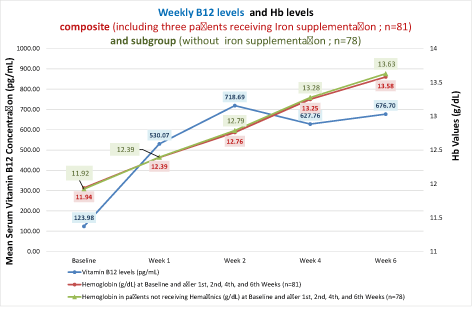
Appendix Supplementary Figure 1: Hemoglobin (g/dL) in all patients (“composite”, n=81) vs. patients who did not receive Iron supplementation (“subgroup”, n=78).
Hemoglobin levels progressively increased from baseline hemoglobin of 11.92 to 12.39, 12.79, 13.28 and 13.63 g/dL after the 1st, 2nd, 4th, and 6th weeks respectively. In other words, the rise of hemoglobin was seen irrespective of iron supplementation. Reticulocyte count, demonstrated trend consistent with erythpoietic activity: a borderline higher value at 1st and 2nd weeks; and once hemoglobin approached 12.76 g/dL, the reticulocyte count started normalizing; but the hemoglobin kept rising till normal (Appendix: Supplementary Figure SF2).
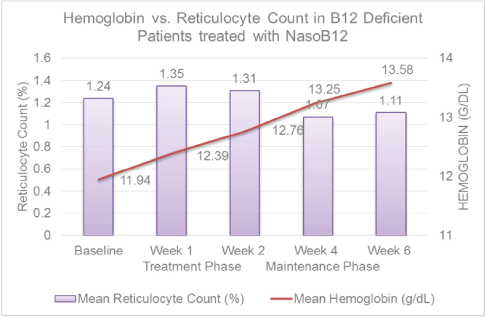
Appendix Supplementary Figure 2: Hemoglobin versus reticulocyte counts.
Physician’s global assessment of efficacy: Physicians rated the treatment efficacy as “excellent” or “good” for 98.7% of patients (58% and 40.7%, respectively) (Figure 3).
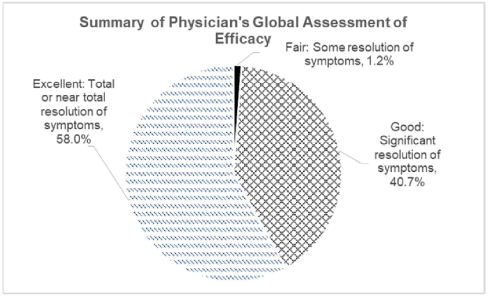
Figure 3: Physician’s global assessment of efficacy.
NasoB12® was well-tolerated. The most common adverse events were gastrointestinal, metabolism and nutrition disorders (3.9% [n=4] patients each). No deaths/ serious/ severe TEAEs were reported. Overall 14% patients reported 26 events of which 11 were considered treatment-related. One patient experienced a mild non-serious TEAE (nasal congestion) which resolved without any treatment being required (Table 2 and 3).
| Patient Category | n (%) |
| Number of events | 26 |
| Number of treatment-related events | 11/26 (42.3%) |
| Number of patient(s): | |
| With at least one event | 14/103 (13.6%) |
| With at least one severe event | 0 |
| With at least one serious event | 0 |
| With at least one treatment-related event | 5/103 (4.9%) |
| Note: Treatment-related Adverse Events are events with relationship indicated as: ‘Certain’ or ‘probable’ or ‘possible’ or ‘missing’. | |
Table 2: Overall summary of treatment-emergent adverse events (Safety Population; Total n=103).
| System Organ Class Preferred Term |
n (%) |
| Gastrointestinal disorders | 4 (3.9) |
| Diarrhea | 2 (1.9) |
| Dyspepsia | 1 (1.0) |
| Nausea | 1 (1.0) |
| Vomiting | 1 (1.0) |
| General disorders and administration site conditions | 2 (1.9) |
| Peripheral swelling | 1 (1.0) |
| Pyrexia | 1 (1.0) |
| Infections and infestations | 1 (1.0) |
| Bacterial infection | 1 (1.0) |
| Injury, poisoning and procedural complications | 2 (1.9) |
| Phlebitis | 2 (1.9) |
| Metabolism and nutrition disorders | 4 (3.9) |
| Decreased appetite | 1 (1.0) |
| Iron deficiency anemia | 3 (2.9) |
| Musculoskeletal and connective tissue disorders | 1 (1.0) |
| Temporomandibular joint syndrome | 1 (1.0) |
| Nervous system disorders | 2 (1.9) |
| Headache | 2 (1.9) |
| Hypoaesthesia | 1 (1.0) |
| Paraesthesia | 1 (1.0) |
| Reproductive system and breast disorders | 1 (1.0) |
| Breast pain | 1 (1.0) |
| Pelvic pain | 1 (1.0) |
| Vaginal discharge | 1 (1.0) |
| Respiratory, thoracic and mediastinal disorders | 3 (2.9) |
| Cough | 1 (1.0) |
| Nasal congestion | 1 (1.0) |
| Rhinorrhoea | 1 (1.0) |
| Skin and subcutaneous tissue disorders | 1 (1.0) |
| Pruritus | 1 (1.0) |
| Note: Adverse events were coded using Medical Dictionary for Regulatory Activities (MedDRA) dictionary (version: 20.0) Patients having multiple events within same system organ class were counted only once in respective system organ class under any event. Patients having multiple events with same preferred term were counted only once within the respective PT. System organ class has been sorted alphabetically and preferred terms have been sorted within each system organ class alphabetically. | |
Table 3: Incidence of treatment-emergent adverse events (safety population) display of adverse events (N=103).
The physicians’ global assessment of tolerability: Except for 1 patient, the investigators rated the global tolerability as “excellent” (no adverse event reported) or “good” (mild adverse event; resolved spontaneously; no stoppage of treatment) for all patients in the study (86.4% [n=76] and 12.5% [n=11] patients, respectively).
These are the results of the first prospective, multi-centric, clinical study to evaluate the safety and efficacy of NasoB12®in treatment and maintenance therapy of B12 deficiency. The American Academy of Family Physicians (2017) [2] stratified patients into the following groups:
“Low” (svB12 <150 pg/mL i.e. Classical deficiency),
“Low Normal” (svB12 150-399 pg/mL i.e. Subclinical Cobalamin Deficiency (SCCD1,)) and
“Normal” (i.e. svB12 400 pg/mL and above) [9].
The SCCD concept was not well established when this study was designed and hence the protocol used the cut-off of svB12<200 pg/ mL (148 pmol/L) which was prevailing at that point of time (in 2015). Current scientific consensus (e.g. AAFP) targets the svB12 >296 pmol/l (400 pg/ml and above) as normal levels; [10] hence we would like to utilize this perspective while discussing our results.
Our study did not target symptomatic adults, but included all types of individuals with low B12 levels, because researchers today believe in the existence of a wide spectrum of patients with no symptoms to mild to severe manifestations which could be neuropsychiatric (e.g. neuropathic pain; cognitive impairment), hematologic (megaloblastic anemia; pancytopenia), obstetric (Neural Tube Defects; growthretardation) and pediatric (cognitive; anemia) [2,11-14].
A positive outcome was achieved during the study, as 100% and 95% of patients achieved the primary efficacy endpoint of B12 >200 pg/mL (148 pmol/L) after the 2nd and 6th week respectively.
From the very first week of NasoB12® therapy, the svB12 levels crossed well above 400 pg/mL, into the “normal range” [2]. Subsequently normal svB12 levels were maintained at all time-points, including the 500 mcg once-weekly maintenance therapy. This makes NasoB12® an attractive alternative for both: the treatment as well as the maintenance therapy of B12 deficient patients.
The mean Hemoglobin of B12 deficient patients consistently increased each week from baseline hemoglobin of 11.94 g/dL to 13.58 g/dL at the end of the study (Figure 2), and where only 3.7% patients received a concomitant iron supplementation. Our study corroborates the concept that a rapid rise in B12 levels is associated with a rise in hemoglobin. Andrès E, et al. [13] previously demonstrated this trend in hematological outcomes in 10 patients with B12 malabsorption and cobalamin deficiency treated over 3 months. In contrast, administration of NasoB12® in the current work gave the rise in Hemoglobin (0.45 g/dL, p=0.0002) as early as the 1st week and this trend was sustained till the 6th week, when normal hemoglobin levels were attained (corresponding to a rise of 1.64 g/dL, p <0.0001).
Irrespective of the baseline iron stores, the baseline hemoglobin values were similar and patients experienced a consistent weekly rise in Hemoglobin, both in the treatment phase (alternate-day NasoB12) as well as in the maintenance phase (once-weekly NasoB12).
In our trial 4.9% (n=4) patients did not experience a rise in B12 levels. This appears modest compared to 33% (n=17/51) non-responders reported, after patients received hydroxocobalamin nasal drops for 3 months [14]. The authors suggested that the non-responders had either low B12 protein saturation or a very rapid urinary excretion. In this study the authors used 5,000 mcg one nasal drop in each nostril, twice per week, [14] while the current work employs the scheme with administration of a smaller dose i.e. 500 mcg every alternate day for seven doses, followed by weekly dosing. Small but frequent doses of B12 are known to be more efficient for upload of B12 into the tissues, compared to large but rare doses because low doses do not overload the specific transport system of B12 (in intestine and blood). Excessive vitamin B12 in the circulation, e.g., such as after injections, usually exceeds the binding capacity of specific protein, (Transcobalamin) and is excreted in the urine [1]. NasoB12® was found to be safe, well tolerated and no serious adverse events were reported..
It is now known that there are at least four forms of vitamin B12 (cobalamin), i.e. cyanocobalamin, hydroxocobalamin and two coenzymes forms which are biochemically active, namely methylcobalamin and adenosylo-cobalamin [1,15-17].
Nasal formulations using Cyanocobalamin/Hydroxocobalamin: Cyanocobalamin nasal spray, (Nascobal, USA) is approved only for weekly maintenance therapy, a month after receiving 100 mcg intramuscular B12. The current usage pattern of Cyanocobalamin is that all hematologic parameters should be normal when beginning treatment with Cyanocobalamin nasal spray [18].
Scientific data suggest that the relative bioavailability of the nasal formulations of cyanocobalamin and hydroxocobalamin (versus intramuscular) is 2% [19] to 6.1% [18] and 2% to 5% [20] respectively. Interestingly, authors have concluded that it was time to drop cyanocobalamin [30].
Oral Formulations: Oral vitamin B12 supplementation is considered to be less reliable. For example, a pharmacokinetic study, conducted by Castelli et al, on a “conventional” commercial oral formulation demonstrated an absolute bioavailability of only 2.16% [21].
Limitations of oral therapy: [22,23]
| 1. Poor absorption (by passive transport) |
| 2. Unpredictable and unreliable absorption pattern |
| 3. Not reliable for the treatment of pernicious anemia |
| 4. Not suitable for patients with nausea, vomiting or who are unable to tolerate oral medication |
| 5. Concerns about swallowing difficulties |
| 6. Non compliance due to long term daily dosing |
| 7. Due to poor absorption, cost to benefit ratio does not favor oral therapy |
Sublingual Formulations: While, oral therapy may not be appropriate for those with swallowing difficulties, an alternate route of therapy for vitamin B12 deficiency is by the sublingual mucosa [24]. There is less clinical data on sublingual formulations of Vitamin B12. However, since vitamin B12 is a large molecule, which is hydrophilic, the absorption needs to be confirmed. Absorption of vitamin B12 from sublingual formulation may actually take place from the GI tract, after saliva has cleared the dose from the oral cavity. Thus oral or sublingual supplementation requires a higher dose of vitamin B12 to be administered and does not provide a predictable increase of vitamin B12 in the body.
Parenteral administration; intramuscular (IM) or intravenous (IV): IM/IV is often preferred to reliably treat vitamin B12 deficiency by clinicians. Patients with previous stomach and terminal ileum resections are often treated with IM or IV vitamin B12 injections. Usually, the patient is put on a lifetime regimen of monthly maintenance injections. From a clinical perspective, vitamin B12 injection is painful and difficult to administer to disabled or elderly patients. Besides, the patient needs to visit a health professional repeatedly, leading to inconvenience and hence, compromised compliance.
Limitations of parenteral therapy: [25-27]
| 1. Not ideal route for vitamin B12 supplementation in elderly due to loss of muscle mass (Sarcopenia) and they are often on anticoagulants |
| 2. Frequent need of health professional’s assistance, makes patient dependent. |
| 3. Very inconvenient due to frequent visits to the clinics, hence promotes non-compliance. |
| 4. Painful and long term injection lead to inconvenience and non- compliance |
| 5. Injection site related adverse reactions. |
| 6. Allergic reactions and severe anaphylactic reactions are reported. |
| 7. Cost of overall treatment is high. |
In contrast to oral Vitamin B12 therapy, Nasal B12® is associated with rapid, consistent, predictable and reliable absorption. Nasal B12® can be self- administered with high compliance, even by patients with swallowing problems, nausea or vomiting, or with absorption issues, including pernicious anemia, post-bariatric surgery and malabsorption.
In contrast to injectable vitamin B12 therapy, Nasal B12® has lower cost, lower manpower burden, does not require a patient of an accompanying person to visit a healthcare facility, is self-administered and painless, has few adverse events, and has high compliance.
NasoB12® is the world’s first Methylcobalamin nasal spray, designed and delivered keeping light-sensitivity in mind.
NasoB12® was well tolerated and associated with a rapid rise of hemoglobin.
Our data opens the door for more research on how the formulation delivery system and packaging, which protect vitamin B12 from light, would lead to clinically meaningful outcomes in the real world.
Our intention was not to study the underlying cause for low Vitamin B12 levels, but rather, to correct them, irrespective of the underlying causes. Future researchers may well study the effect on various dietary patterns and etiologic subtypes. This study excluded patients with neurological symptoms, pregnant and lactating women and children; hence, future studies are needed to see the effect in these patients. The subjects were followed up for six weeks; and hence, a clinical trial is being planned with a longer follow-up, comparing NasoB12® with Oral/ Injectable B12 in “Low-Normal/Sub-clinical Cobalamin deficiency” (B12 150-399 pg/ml) patients and in overtly symptomatic, clinically deficient (B12 <150 pg/ml) patients.
Along with a rise in B12 levels, a hematopoietic response is important, [28,29] and we observed such a response in our study. Some other publications reported the serum B12 level, but did not follow hematopoietic responses [30,31-34]. A strong point of this work concerns monitoring of hemoglobin and reticulocyte changes, but larger, population-based studies are needed to confirm this effect. We have not done the MCV, MMA and Homocysteine but in future research these parameters will be included. Given the rise of Hemoglobin with NasoB12®, future studies could be designed for pernicious anemia, and also focus on the children, adolescents, women, especially pregnant women and the elderly [29,30,35].
In the present clinical study, at the end of treatment phase, a statistically significant rapid rise in mean serum vitamin B12 levels was achieved and maintained till the end of the maintenance phase. NasoB12® was associated with a favorable hematopoietic response. Therefore, NasoB12® can be beneficial for the treatment and maintenance of serum vitamin B12 levels in patients with low serum Vitamin B12 levels. Thus, NasoB12® offers a fast and consistent alternative to oral or sublingual B12 therapy; and a simpler and convenient alternative to B12 injections, without safety concerns.
Supplementary figures [SF1 & SF2].
Conceptualization, methodology, study conduct, formal analysis, access to all data, verification of data and interpretation: TS, VS, DB, SM, AA, PP, PC; writing-original draft preparation, TS, VS, DB, SM, AA, PP, PC, writing-review and editing, TS, VS, DB, SM, AA, PP, PC, visualization, TS, VS, DB, SM, AA, PP, PC. All authors have read and agreed to the published version of the manuscript.
This research was funded by Troikaa Pharmaceuticals Limited. Grant number INMEC-CT.
CTRI No: CTRI/2015/06/005952 at www.ctri.nic.in.
We are grateful to all our patients and their care-givers.
The authors declare no conflict of interest. The funders had no role in the design of the study; in the collection, analyses, or interpretation of data; in the writing of the manuscript, or in the decision to publish the results.
Download Provisional PDF Here
Article Type: RESEARCH ARTICLE
Citation: Seth T, Suri V, Balat D, Murthy S, Agarwal A, et al. (2021) Rapid and Safe Correction of Vitamin B12 Deficiency using Novel Methylcobalamin Nasal Spray. Int J Endocrinol Metab Disord 7(1): dx.doi.org/10.16966/2380-548X.172
Copyright: © 2021 Seth T, et al. This is an open-access article distributed under the terms of the Creative Commons Attribution License, which permits unrestricted use, distribution, and reproduction in any medium, provided the original author and source are credited.
Publication history:
All Sci Forschen Journals are Open Access